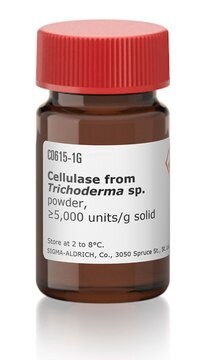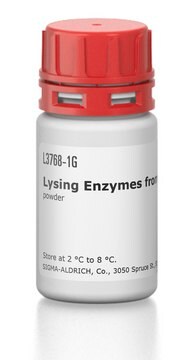P3026
Pectolyase from Aspergillus japonicus
lyophilized powder, ≥0.3 units/mg solid
Synonyme(s) :
Pectolytic enzyme
About This Item
Produits recommandés
Source biologique
Aspergillus sp. (A. japonicus)
Forme
lyophilized powder
Activité spécifique
≥0.3 units/mg solid
Poids mol.
50 kDa
Caractéristiques du produit alternatif plus écologique
Waste Prevention
Design for Energy Efficiency
Learn more about the Principles of Green Chemistry.
sustainability
Greener Alternative Product
Autre catégorie plus écologique
, Enabling
Température de stockage
2-8°C
Vous recherchez des produits similaires ? Visite Guide de comparaison des produits
Description générale
Pectolyase or pectin lyase is stable in the temperature range of 40-50°C and is a 50 kDa enzyme with an isoelectric pH of 3.8.
Application
- in the lysis of chlorella cells for protoplast generation
- as component of enzyme digestion buffer for Arabidopsis meiotic chromosome isolation
- to induce reorganization of Arabidopsis root cap cell architecture
Actions biochimiques/physiologiques
Autres remarques
Définition de l'unité
Code de la classe de stockage
11 - Combustible Solids
Classe de danger pour l'eau (WGK)
WGK 3
Point d'éclair (°F)
Not applicable
Point d'éclair (°C)
Not applicable
Équipement de protection individuelle
Eyeshields, Gloves, type N95 (US)
Certificats d'analyse (COA)
Recherchez un Certificats d'analyse (COA) en saisissant le numéro de lot du produit. Les numéros de lot figurent sur l'étiquette du produit après les mots "Lot" ou "Batch".
Déjà en possession de ce produit ?
Retrouvez la documentation relative aux produits que vous avez récemment achetés dans la Bibliothèque de documents.
Les clients ont également consulté
Articles
A key resource feature at our Enzyme Explorer section of biochemicals is "Enzymes for Carbohydrate Analysis and Digestion." Offering kits, reagents, analysis, lists of enzymes related to PTM and carbohydrate metabolism.
Notre équipe de scientifiques dispose d'une expérience dans tous les secteurs de la recherche, notamment en sciences de la vie, science des matériaux, synthèse chimique, chromatographie, analyse et dans de nombreux autres domaines..
Contacter notre Service technique







